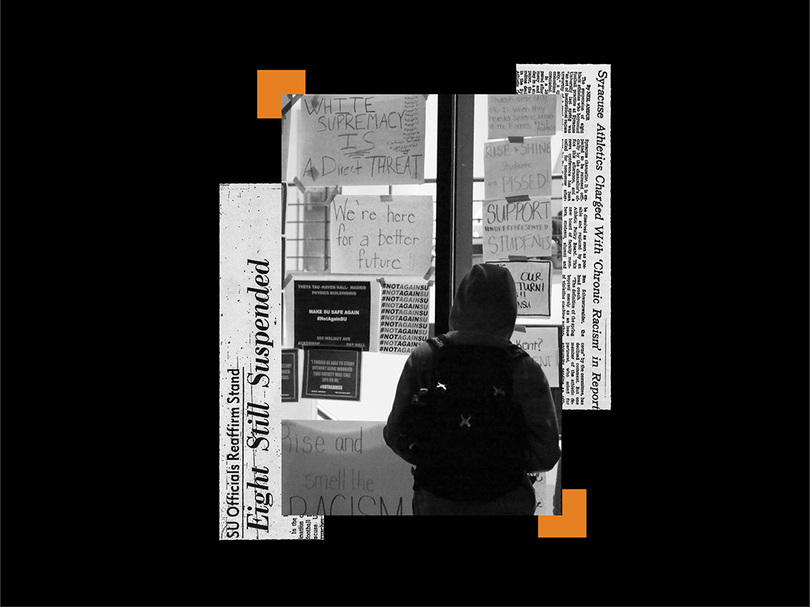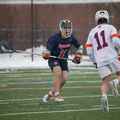Like the Syracuse 8, #NotAgainSU presented the university with demands and faced criticism while seeking to make Syracuse safer for underrepresented people. #NotAgainSU’s movement, according to its original mission statement, aims to change “systems of oppression that are upheld and protected” by SU’s administration, mirroring the Syracuse 8’s fight against institutional racism.
Both the Syracuse 8 and #NotAgainSU organizers fought for inclusivity but encountered broken promises, which fractured trust in the administration. When Syracuse temporarily suspended #NotAgainSU protesters in February, the movement retweeted a post comparing the situation to the Syracuse 8.
#NotAgainSU’s demands included a revised curriculum to address modern diversity issues, mandatory diversity training for faculty and more counselors that represent marginalized identities on campus. The Syracuse 8 fought for equality in athletics and an integrated coaching staff. Some members were also involved in other causes, like establishing a Black student union and a Black studies program.
“Hate ain’t dead,” Lobon said. “It just raised its ugly head again. What you have to have is right-minded people understand that you know what, we can’t keep going through these things because what it’s going to do is create chaos and misunderstandings.”
Athlete activism expert and former Syracuse men’s basketball star Etan Thomas visited #NotAgainSU’s occupation of Crouse-Hinds in February. He recognized the similarities between their movement and the Syracuse 8. Both fought for causes that “should’ve been in place already,” Thomas wrote in an email.
Several current Syracuse athletes joined #NotAgainSU in their own way last November. Players showed support on social media, SU’s men’s basketball players wore #NotAgainSU warmup shirts and some football players participated in the Barnes Center sit-in. Football players who stayed silent during the Theta Tau incident in 2018 couldn’t stay on the sidelines any longer.
“This was the same 50 years ago: Those young men being athletes is secondary to them being Black men,” Dana Harrell said. “They have a voice as Black men whether they were piano players, football players, scientists, whatever they are. This is an issue that they have to address as Black men.”
Those young ball players that are on the team now, and the Black athletes at Syracuse University in general, they don't know about the Syracuse 8. And they need to know. Everybody in the university, including white people and other people of color, need to (know the history).Clarence McGill, Syracuse 8 member
When Harrell arrived on campus as a freshman in 1968, there were roughly 75 students of color at SU. As of fall 2019, 48.1% of Syracuse’s student body identifies as people of color or international students, according to the Office of Institutional Research and Assessment. Out of Syracuse’s 23 peer institutions, it has the 15th-highest campus ethnic diversity index as of fall 2018, per US News.
“We still have issues today,” Harrell said. “We still have challenges. Black people still have challenges. Athletics still have challenges. America still has challenges. Football still has challenges. But the hope is to strive … we’re always striving for that more perfect union, aren’t we? We ain’t never going to get there. But you gotta keep striving.”
In the summer the Syracuse 8 boycotted, 68 white players staged a counter-boycott and opposed reinstatement of the Black players. They signed a petition in full support of head coach Ben Schwartzwalder, who divided the team and labeled the Syracuse 8 as troublemakers. Joe Ehrmann, one of the white leaders on the 1970 team, vehemently opposed the boycott at the time but has since admitted he was wrong.
With #NotAgainSU, many students and faculty have expressed support on social media or by joining protests, but some have called the movement’s lack of respect for authority dangerous and said both the organizers and the administration have handled controversies irresponsibly. In January, Syracuse briefly denied organizers access to food and necessities outside Crouse-Hinds.
While occupying Crouse-Hinds one month later, #NotAgainSU added a demand that would include the Syracuse 8’s story — as well as the Black Panther protests, THE General Body and Recognize Us — in the SEM 100 curriculum.








